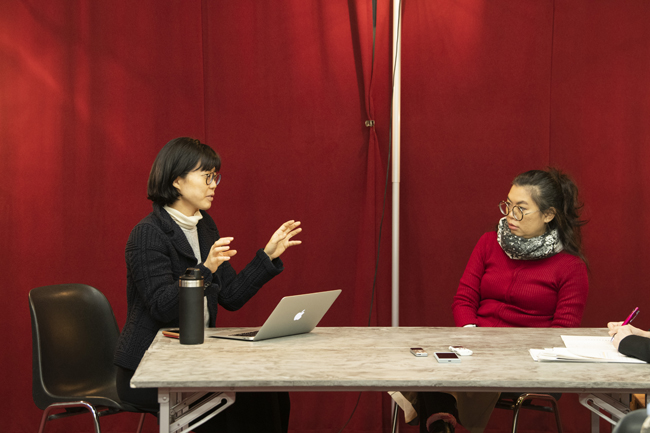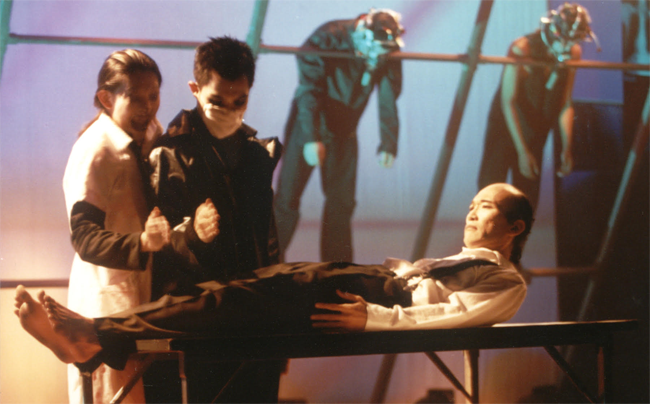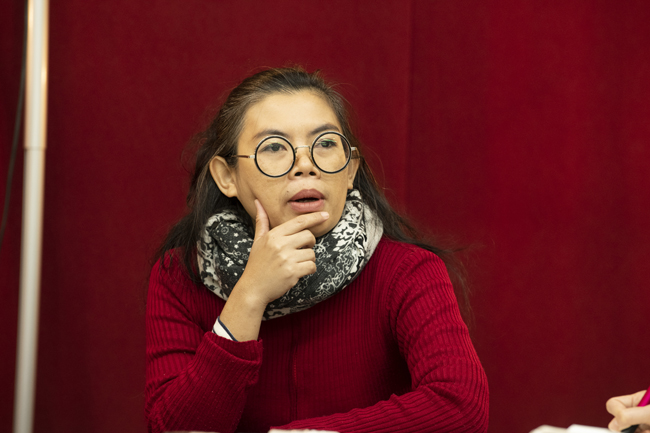As a co-artistic director: B-Floor is a physical theatre company, an artist collective, and a space for workshops and performances. What are the realities of this company, which leads the performing arts scene in Bangkok?

Nakamura: B-Floor may be one of the most famous Bangkok physical theatre companies in Japan. It has collaborated with FAIFAI, started at the initiative of Mr. Hideki Noda (at the Tokyo Metropolitan Theatre in 2010). B-Floor was also invited to Ueno Storehouse two years in a row (2018 and 2019).
But the Japanese audience does not know what each member of the company does or its history. They tend to identify the company with the other co-artistic director, Teerawat Mulvilai (Ka-ge, who also participates in PRATTHANA as an actor). What role do you play in B-Floor?
Jaa: B-Floor is more appropriately characterized as a collective of artists with various backgrounds. I play different roles in different productions. I can perform as an actress, produce and direct productions, or I can be a dramaturg. Each member exchanges his or her roles in every production. As a co-artistic director I raise funds, manage, and run the company. On top of this, I contact and coordinate other artists. I also manage the space and look for venues.
Nakamura: What is your artistic role as a co-artistic director?
Jaa: Of course, I am engaged in developing the company's annual policy. Every year we have to decide where the company is and in what direction it is heading, or whether it needs to be corrected. But we are not like this: the co-artistic directors make a decision, which all members must follow. We must talk first. Whatever project we have, we put forward our plan to discuss it with members; we ask them if they can agree with it, and who is going to participate in it. We also discuss the direction in which we can work together. For example, this year a member suggested that we want to present our shows not just in Bangkok but in regional prefectures in Thailand, which has since become our policy.
Nakamura: What is characteristic to B-Floor is of course its co-artistic directors, that is, you and Ka-ge. But not just this; other members are highly committed and are on equal footing crossing over generations. B-Floor builds on a high level of "consciousness" as a theatrical company. It's not at all the case that a powerful leader is supported by collaborators who embody her values; on the contrary, other members publish works of art as artists and are highly acclaimed. Even productions under the name of B-Floor can be directed by Pupe (Sasapin Siriwanij, one of the actors of PRATTHANA) or you. You share visions with your colleagues to create a network of mutual support through which all of you help one another in a creative environment. But at the same time, the B-Floor brand is widely recognized for its creative quality. This makes what the company is very unique. Could you tell us how such a company came into being? First, how did it start?
Jaa: We haven't determined when B-Floor was actually established. It was occasioned by the Bangkok Fringe Festival held at the Patravadi Theatre*3 in Bangkok about 20 years ago. At the festival, many people got together, including Crescent Moon Theatre*4, International WOW Company*5 , and other independent artists, who constituted B-Floor. We then decided to create a joyful theatrical production. We wanted to experiment with non-linear form, which was a considerable success. We also had very good reactions from the audience. As we enjoyed it, we restaged it and had two or three more productions. That's how we became something of a company. Since then, founding members left us in 2008 or 2009. In 2005 through 2006, new members joined us; some left and others came; and in 2008 we wondered who composed B-Floor and reshaped it as a group, which continues to this day. More members have since joined us. We have 10 members right now, but the original founding members are only two of us, that is, Ka-ge and me.
*3 The Patravadi Theatre
An open-air theatre established in 1992 by Patravadi Mejudhon, an actress, stage director, and novelist. Equipped with a small theatre, café, and residential space, it functioned as a site that led modern Thai theatre. It closed in 2011; before that Patravadi High School was opened in Hua Hin, which teaches the performing arts. The school has elementary classes as well.
*4 Crescent Moon Theatre
Crescent Moon Theatre was founded in 1969 by students of Thammasat University. It is a well-established modern theatre company that remains active down to this day.
*5 International WOW Company
Founded in 1996 by a group of theatre and dance artists from Thailand, Indonesia, Japan, and the US.
Nakamura: Speaking of the Fringe Festival at the Patravadi Theatre 20 years ago, Pichet Klunchun*6 , for example, began his theatrical career at the Festival. Some years later, Tang Fu Kuen*7 became director. In any case, the Patravadi Theatre, which no longer exists, seems to have provided a leading platform for modern theatre 20 years ago. What do you think of the momentum of the stage art scene at that time?
*6 Pichet Klunchun
Pichet Klunchun bridges traditional Thai Classical Dance language with contemporary sensibility, while keeping the heart and wisdom of the convention. He founded Pichet Klunchun Dance Company in order to create pure art performance and to train young-blood professional dancers with strong Thai classical dance backgrounds.
*7 Tang Fu Kuen
Tang Fu Kuen is an independent cultural worker in contemporary performance and visual fields, working in Asia and Europe. Since 2018 Fu Kuen is Curator of Taipei Arts Festival.
Jaa: The theatre world was very active back then. .In 1995, many theatre groups like Theatre 28*8 and Crescent Moon Theatre were active, also some other small groups were shaped, Sang Arun Art and Culture Center*9 and diverse festivals as well as Patravadi Theatre were such platforms for them. Since then, the Asian financial crisis (1997) occurred and the economic bubble burst. The theatrical momentum also faded. Some large theatres disappeared. Members of Theatre 28 gradually began to do non-theatrical activities.
*8 Theater 28
Theatre 28 was founded in 1985. Most of the productions were translated or adapted from western scripts for example, Hamlet; the musical, Galileo and Man of La Mancha. Some of the members are Euthana Mukdasanit, Rassamee Phaoluangthong.
*9 Sang Arun Art and Culture Center
Sang Arun Art and Culture Center located on the 5th Floor of Plan Toys building, Sathorn 10 road, Bangkok. It was very active for theatre in 90's but declined its activities during economic crisis. In 2019, it starts being active again and hosts various shows including Wichaya Artamat's Siamese Femme Fatales and B-floor's new production by Ka-ge Mulvilai called Trance will be also performed there in September 2019.

What was the small theatre scene in Bangkok when B-Floor was established to treat prostitutes, LGBTs, discrimination and disparity that caused oppression and the poverty problem?
Nakamura: The prototype of B-Floor took shape in such a period. What kind of play did you create at that time?
Jaa: The first play Ka-ge and I created was Medah, inspired by a song of Jaran Manopetch, a singer*10 . It is about a beautiful widow living in a country village. She teaches young men in the village how to have sex. Anyone who is interested can go to her house and make love anytime. At that time, women being duped into prostitution was in the news. I wanted to pose the question: "Does a woman's body really belong to her?" Medah has a story with very few lines. It was more like a performance that had many actors, about 13 to 15. The second work was Well..Hitler Stole My Pink Piggy Doll, mainly written by Ka-ge. This reproduced Charlie Chaplin's gestures in his monochrome silent films.
*10 Jaran Manophet
Jaran Manophet was a singer, songwriter and actor who was acclaimed as one of the greatest folk song artists from Northern Thailand. He used Northern Thai dialect in every song of him and wrote more than 200 songs.

Photo by Tawit Keitprapai

Photo by Tawit Keitprapa
Nakamura: Was it a film?
Jaa: No, it was a stage work. Imagine monochrome pantomime cinema, in which people make awkward movements as frames advance, which we reproduced on the stage. The way Chaplin moves in cinema was re-enacted on the stage. More than 10 actors appeared.
Nakamura: Even since the early days, you like to have many actors...
Jaa: Everybody had time [laughs].
Nakamura: Talking about sexual intercourse or prostitution is, I guess, generally a taboo. Content-wise, did you have a sense of distance from society?
Jaa: Productions then were quite diverse, treating prostitutes, LGBTs, discrimination and disparity that cause oppression and the poverty problem. Small theatre groups then preferred to create such works, which in turn became a general theme in the theatre world. For example, we had Makhampom Theatre*11 , Moradok Mai [New Heritage]*12 , and other theatre groups. There was also Theatre 28, our senior. They adapted foreign scripts or stories to the stage. Such plays discussed social themes. I have no special memories of being criticized in society. But then we had a very small and limited audience. In those days stage art and drama were not well understood in Thailand.
*11 Makhampon Theatre
Makhampon Theater began its theatrical activities in the 1970s, when democratic movements flourished in Thailand. It focuses on regional problems in communities facing various issues.
*12 Moradok Mai
Moradok Mai Theatre Troupe founded by Chonprakan Junreung in 1997. The troupe was once located in middle of Bangkok but now move to Pratumthani province and has its own program as a home school where performing arts is a center of learning.
Nakamura: Hitler and Chaplin, for example, evoke the image of a "dictator". Some people may have taken it as a specific reference to the power structure and its situation in Thailand. Did you receive critical views for such a social message?
Jaa: Not as far as I know. Or rather, I should say that I did not notice them. At that time there was no social media to promptly provide feedback from audiences. People may have regarded us as a small obscure group that was irresponsibly telling its stories somewhere.
Nakamura: Did you treat political topics because you were frustrated with the limited freedom of expression due to social oppression?
Jaa: I wasn't aware of the problem. In hindsight, I believe I was unconsciously oppressed by Thai society. That's how I see it now. For Thailand had then the poverty problem as a social issue. In fact, I had heard the story of a man who sold his organs and eventually died because he had no money. This prompted me to write a story in which a factory worker gets ill and tries to escape from capitalism. I incorporated a scene where he goes to the hospital to sell his organs. As in Charlie Chaplin's Modern Times, the man runs away from the empire of the factory owner who was like a dictator. Such is the plot of the play. Thinking of the situation in which we were caught up in those days, I naturally took interest in such a social theme, which was something we could relate to.

Nakamura: Then the Asian financial crisis occurred in 1997 and the flow of the theatrical scene changed. Could you tell us what it was like back then?
Jaa: One thing definitely changed. Before the financial crisis, theatre companies like Crescent Moon had sponsors who provided good working conditions for them, like company employees. They had monthly salaries. When they had rehearsals, they worked from 8 in the morning till 5 in the evening. But after the financial crisis such sponsors vanished. Theatres like Sang Arun closed. Artists working there became freelancers. Companies had to raise funds themselves in order to run. Actors had other jobs so as to continue to work in the theatre. Small-scale groups and plays increased and large-scale projects and work became much rarer. That's how I remember it.
Nakamura: I can hardly imagine that they had such a stage environment with nice treatment like company employees. Was B-Floor itself in such an environment in creating plays?
Jaa: No. B-Floor did not pay monthly salaries. It was more like a group of freelancers. Only a small number of companies, such as Crescent Moon, provided good treatment like company employees. They had big corporate sponsors. Patravadi Theatre also had a monthly salary plan.







